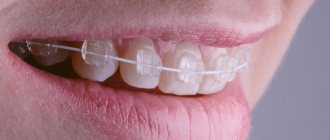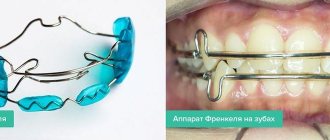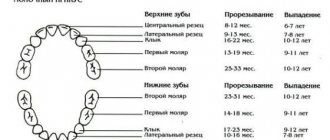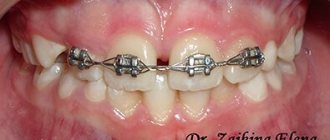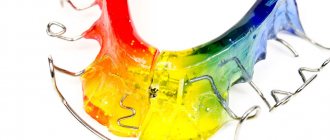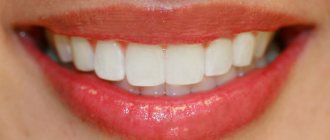Logic will help you get from point A to point B, imagination will help you get anywhere! Einstein
The most common questions we are asked by orthodontists around the world concern the shape of the arches and the sequence of their replacement.
This article will explain why we believe in Pitts Broad, a relatively new archwire design that provides the most esthetic solution in orthodontics today, and why the Pitts Broad archwire progression sequence is rational, effective, and simple. I have been working on the topic of arch shapes and arch sequences since my residency. During this time I have accumulated a lot of information. When I studied at the University of Washington from 1968 to 1970 under the tutelage of Drs. Richard Riedel and Alton Mohr, I was taught that to achieve stability, the shape and width of the arch should reflect the original shape of the dental arch before treatment. 35 years of collecting and processing information in the Department of Orthodontics at the University of Washington has led me to conclude that long-term stability is very unpredictable.
Picture 1:
The Evolution of Aesthetic Arch Shapes: A Preference for Pitts Broad Arches - Courtesy of Tom Pitts 2013
Figure 2:
Pitts Wide and Utility Arc Comparisons - Courtesy of Tom Pitts 2013
“Orthodontic treatment is inherently unstable and without retention, relapse is inevitable.”
Because of these advances, my clinical experience, and the clinical experience of the thousands of orthodontists I have taught and interacted with throughout my career, I believe in lifelong sleep retention after orthodontic treatment is completed.
Figure 3:
Aesthetic changes associated with changes in archwire shape due to the application of curves to corrective archwires - Courtesy of Tom Pitts 2013
Almost immediately after graduating from university in 1970, I attended the first FACE continuum, where I studied with Dr. Ron Roth. Dr. Roth imagined an arch in the shape of a horse's hoof, very wide at the front. Using this archwire for some time, I realized that treating clinical cases with archwires that are too wide and flat anteriorly and too narrow in the molar area does not create an aesthetically acceptable effect in the final phase of treatment.
Later, a group of innovative orthodontists with whom I collaborated (the A company Innovation Group) developed an arch shape that is sometimes called the Universal or Damon arch shape. This archwire shape has been consistently adopted by many orthodontists around the world and has proven to achieve more esthetic results than previous archwire shapes. I used the Universal and Damon arcs for many years and for me, it was still not enough.
Figure 4:
Aesthetic shapes are obtained by applying curves to the arches and become the basis for the wide Pitz arches (without distalizing the molars) - with permission from Tom Pitts 2013
During the treatment of patients, insufficient width in the posterior region was observed and further treatment with bends on the arches was required. The duration of such treatment from the stage of nickel-titanium arches to the stage of using corrective arches (TMA or stainless steel arches), where further alignment in the posterior area depends on the bends in the arch, takes from eight months to a year. This is effective, but not rational.
Figure 5:
The aesthetic goal is a wider smile, not too wide at the canine area, a delightful smile arc, full enamel alignment when smiling and optimal incisor inclination - courtesy of Duncan Brown
When I participated in the continuum of Dr. Robert Ricketts in 1975, I began to evaluate the treatment results achieved in terms of the aesthetics of the arch shape, offering less width at the canine site and greater width at the molar site. This arch shape resulted in a very aesthetic smile with a decrease in the space of the buccal corridors. I began to inherit this shape with the help of corrective archwires, gradually increasing the width in the molar area to maximize the filling of the buccal corridors with teeth. (Figures 1–3). The result is a reflection of modern concepts of dentistry, when the disposition of 12 teeth during a smile is considered the most aesthetic.
Figure 6:
Width and shape of the arch varies according to aesthetic purposes - courtesy of Duncan Brown 2016
Obviously, some “thinking outside the box” should, in turn, give impetus to the development of an entire system (bracket geometry, archwire shape, archwire sequence) that is rational, effective, easy to use, easy to teach, and allows the orthodontist to consistently achieve exceptionally aesthetic results . Fortunately, OS Orthodontics' corporate culture always strives for significant innovation.
Figure 7:
Aesthetic changes associated with a change in the shape of the dental arch created using a corrective arch – courtesy of Tom Pitts 2013
Arch shape and today's aesthetic and functional expectations:
Today I talk and show photographs of ideal smile aesthetics to potential patients. They readily appreciate the aesthetic value of full lips, wide smiles, a well-defined smile arc, fullness of the maxillary teeth during smiling, and optimal inclination of the incisors for aesthetic reasons. Inevitably they will all say, “I want this.” Anticipated age-related changes in the face during aging should be considered in the treatment plan as an initial goal and not as an additional idea. (Figures 4–9).
Figure 8:
The aesthetically directed arch shape created by applying curves became the basis of the Pitts broad arch – courtesy of Tom Pitts 2013
There is an increasing number of fans of non-excision treatments to satisfy aesthetic needs around the world. Unfortunately, for many, the biomechanics of non-extraction treatment are often associated with the need to control proclination of the upper anterior teeth while addressing crowding. As we mentioned in the previous version of the protocol, control of axial tilt can be achieved using active early protocols by rotating the H4 brackets 180°. For more information regarding active early protocols, see the overview on this topic in this article and also in Section 2 - Protocol.
Figure 9:
Aesthetics achieved with a wide arc according to Pitts Pitts broad creates “Wow!” smiles – courtesy of Nimet Guiga 2016
For many years, at the same time as widening the buccal segments to control anterior axial tilt in non-extraction cases with potential for proclination, I have flipped the upper anterior brackets. Another challenge to expanding premolars and molars with a fixed appliance is that the axial inclination of the buccal segments must be controlled. Even though we use brackets with a torque of -27 degrees on the upper molars and -22 degrees on the lower molars, sometimes during expansion in the posterior region, we add a little torsional moment to the arch.
Figure 10:
A wide smile, remarkable smile curvature and full enamel alignment during smiling become critical in patients with small teeth - Courtesy of Duncan Brown 2016
Our searches confirmed that the final arch width is a function of the arch shape rather than the brackets used during treatment. In response to the need for an improved arch shape that is wide in the molar region (to fill the buccal corridors), narrow in the anterior region (for better incisor expression), and slightly narrower than traditional arch forms in the canine and first premolar region (for better positioning 12 -ty teeth while smiling) I invented the wide arch shape according to Pitts Broad. For most patients, this arch shape creates a 12-tooth smile. I worked with OS engineers to design all the arcs I use, both the Pitts Broad and the universal ones. Beginning treatment with Pitts Broad Thermo-Active Nickel Titanium (TA NiTi) wires can achieve very rapid expansion and are part of an early active protocol.
Figure 11:
The aesthetic goal of optimal incisor angulation - Courtesy of Duncan Brown 2016
In dental aesthetic circles, the aesthetic concepts of the “Golden Proportions” have been very successfully supplanted by the concept of “Virtual Crown Width”. This refers to a description of the visual expression of aesthetically straight teeth and we adhere to this concept. For us, transverse expansion does not depend on the size of the teeth or whether the treatment is extraction, since it is a separate form of the arch, which must meet aesthetic requirements and biological possibilities. We reject the concept that patients with reduced overall tooth size (after extractions or reduced mesiodistal width of anterior teeth) should be treated with narrow arch forms. In my opinion, the shape of the arch is more important for aesthetics than the proportions of the sizes of the anterior teeth among themselves (Figures 10–15).
Figure 12:
Width and shape of the arch varies according to aesthetic purposes - courtesy of Duncan Brown 2016
Caution should be exercised when expanding premolar and molar sites in patients with a thin periodontal biotype. We refer to the concept proposed by Dr. Michael Mejore (Edmonton, Alberta) of continually assessing the patient's biological limitations to achieve the desired tooth movements. In patients with a thin biotype, thin labial/buccal/lingual bone at the level of the root endings, or in patients with bone fenestration already present, I modify the arch shape, do a very slight widening, and palpate the labial and lingual sides at each visit. This is a direct compromise when established biological limitations exceed aesthetic requirements.
Figure 13
As already mentioned, achieving transverse expansion of the area of canines, premolars and molars is very effective on round thermoactive arches. OS provides a full range of arches of different sizes and sections, and already at the initial stage it is possible to achieve the desired shape of the dental arch, which previously could be achieved by applying bends to the corrective arch. OS offers the following archwire shapes (Figure 1): Pitts Broad (which we use most often), Pitts Standard (we use less frequently), and Universal (for patients with biological limitations or for wide lower arches and low values). torque).
Figure 14
The use of beta titanium or stainless steel wires allows subtle adjustments to be made in the final arch shape to suit aesthetic requirements, biological limitations and minor torque corrections. In Active Early treatment, where torsional control and lateral expansion of the archwire is achieved early in treatment, stainless steel archwires will be required less frequently, but are available for those who enjoy using them
Facial bow in orthopedics
Dentures are made individually for each patient, taking into account the structure of his dental system. To do this, a few years ago, the prosthetist took impressions of the teeth, described the bite and sent the data obtained to the dental laboratory, where the prosthesis was made in strict accordance with them. Theoretically, the orthopedic product should have “fitted” perfectly, but in practice the doctor sent it to the laboratory several times for revision. The grueling “adjustment” was associated mainly with the specific trajectory of movement of the lower jaw, a clear idea of which was not given by either dental impressions or a description of the bite. It was possible to fill the gap in data thanks to the facial bow, which models the position of the jaw in three-dimensional space, and allows you to create not only a comfortable, but also a harmonious denture that matches a person’s facial features and makes his smile natural.
Design and types of orthopedic facial arches
A facebow is a U-shaped metal plate equipped with a bite fork and secured to the head with stops. There are two types of orthopedic face bows:
- Medium anatomical (synonyms: portable, standard) facebow. The device is fixed using the nose and ear stops. Used to create complete removable dentures.
- Kinematic (synonym: axial) arc. The device is fixed at the point of the chin and the midline of the forehead; establishes not only the relationship of the jaws, but also their axis during movement. Used in the manufacture of partial dentures from acrylic and elastic materials such as nylon.
Purpose and use of the device
Purpose. The facial bow is a measuring device that establishes the relationship of the upper and lower jaws, as well as their position relative to the bones of the skull. The face bow, including in the St. Petersburg Grandmed clinic, is used both to determine the axis of rotation of the mandibular condyle (the bony protrusion to which the muscles are attached), and to transfer the position of the upper jaw and the axis of rotation of the lower jaw to the articulator.
Application. The face bow is fixed on the head using stops. A bite tray filled with an impression mass is attached to the device, which is introduced into the patient’s oral cavity. The structure is fastened and adjusted with screws. The patient follows the standard instructions of the dentist, the specialist takes the necessary measurements and registers the bite (receives impressions of the upper and lower jaws). Next, the face bow is removed, the data obtained is sent to the laboratory, where it is transferred to an articulator (a device that imitates the movements of the lower jaw). Thanks to the use of a face bow, orthopedic products are obtained that take into account the peculiarities of the orientation and trajectory of movement of the human jaws.
Benefits for the patient
Just a few minutes of spatial modeling using a facebow greatly facilitates the work of the Grandmed orthopedic surgeon and the technician who will manufacture the prosthesis. At the same time, the accuracy of the specialists’ work increases, which means:
- fewer product fittings will be required;
- the period of adaptation will be shortened, and less time will be required to restore chewing and articular functions due to taking into account the anatomical features of the jaws;
- the smile will look aesthetically pleasing, because the teeth in the frontal group will take a natural position relative to the lips, nose and eyes, and will not be adjusted to an abstract “ideal”.
- the prosthesis, supporting teeth and implants with which it is connected are ensured a long service life due to the correct distribution of the load.
Attention! Studies using a facebow do not replace, but complement standard methods of diagnosis and orthopedic treatment, such as taking impressions and determining central occlusion.
Working with arc shape and arc sequence:
In Active Early protocols, the device is activated as early as possible. To do this, brackets are positioned using the Smile Arc Protection (SAP) method to correct the position of the incisors in the vertical plane, brackets are turned over if necessary to activate the torsional moment, a sequence of arches is selected to control axial inclination in the early stages of treatment, arch shapes are used for earlier expansion of the posterior segments, Early Light Short Elastics (ELSE) for force control and appropriate disarticulation to achieve early “desired” tooth movements, as well as extrusion or intrusion.
In contrast to traditional “straight arc thinking,” where forces for torsional correction or lateral expansion are applied for short periods of time late in treatment, the Active Early approach involves using smaller forces for longer periods of time in early stages of treatment.
Figure 15:
Aesthetic goal using Pitz's "Active Early" protocol to control axial tilt early in treatment in a well-cooperative patient - courtesy of Duncan Brown 2014
The Pitts archwire sequence is specifically designed to combine the aesthetically optimized Pitts Broad wires, the reduced buccolingual slot dimensions of the H4 OS brackets, and the early Pitts protocols.
How much does treatment using a facebow cost in St. Petersburg? Price in Grandmed dentistry
In our clinic, when performing prosthetics, a face bow is necessarily used, which allows us to obtain data on the peculiarities of the location of the patient’s jaws, so there is no additional cost for three-dimensional modeling. The cost of treatment using an orthodontic facebow depends on the complexity of the defect, the condition of the dental system, the type of structure fixation and the age of the patient. Since the design can be prescribed to the patient only after the removal of foci of caries and professional hygienic cleaning, and in addition, an X-ray examination (panoramic X-ray, X-ray of the jaws), the cost of therapeutic and diagnostic procedures must be taken into account when determining the full cost of the face bow.
| Service | Price from |
| 3D modeling using a facebow | included in the cost of prosthetics |
| Orthodontic facebow | included in the cost of orthodontic treatment |
Stage 1 – Arch expansion and torsional moment in uncorrected arches
In the past, the recommended archwire sequence for passive self-ligating brackets involved the use of low forces with long intervals between visits to expand the arch laterally while controlling axial inclination with uncorrected archwires early in treatment. This approach is still relevant in cases of severe crowding, and the H4 brackets, with their shorter depth and more precise groove characteristics, offer more treatment options.
The goal of early active protocols using the Pitts archwire sequence is to move to a .020 x .020" thermally active archwire as quickly as possible to simultaneously achieve transverse extension (with Pitts broad archwires) and control anterior axial tilt (due to torsional moment in the groove).
Dr. Ricketts stated that the square archwire is as gentle and effective in achieving torsional torque as the rectangular archwire. This is confirmed by scientific research. Control of dental arch expansion and anterior axial inclination is maintained in the early stages of treatment through the use of lightweight short elastics, byte turbos and other elements of the Active Early approach from the first visit. We prefer to see patients every 6 weeks for the first three visits, during which time a .020 x .020″ thermally active wire is used.
Figure 16:
Most cases start with a thermoset .014" NiTi or thermoset .018 x .018" UltraSoft NiTi (in cases of minor crowding or rotation). Each of these arcs is present in the Pitz wide form. In cases where treatment begins with a .014 NiTi thermally active wire, patients return 6 weeks after fixation, after which the wire is changed to .018 x .018" Ultra Soft Niti for 6 weeks. The goal is to reach the thermoactive .020 x .020" NiTi arch over a period of 6 to 12 weeks and thus trigger a torsional moment developing inside the groove through the arch simultaneously with the continued expansion of the dentition. Square arches work well in place of rectangular arches. Arch .018 x .018 Ultra Soft NiTi is a new arch that we developed at OS.
Figure 17:
For patients who have difficulty eliminating rotations, we suggest replacing the .020 x .020 thermoactive NiTi archwire with a .018 x .025 thermoactive NiTi archwire. With a .025 archwire in the H4 .026 bracket slot, rotation correction is easily achieved with correct bracket positioning.
Facebow in orthodontics
If prosthetists use a facebow to identify the characteristic features of the dental system, that is, for diagnosis, then for an orthodontist, a facebow is a device used together with braces to correct defects caused by a lack of space in the dentition and improper development of the jaw. The face bow is an inexpensive but quite effective device that gives stable results in 4–6 months, which, from the point of view of orthodontics, is a rather short period of time. The bulky appearance of the design, which confuses many patients, is compensated by the ease of its installation and removal and the inconsistency of wear (day or night - at the patient’s choice, but not less than 12 hours a day).
Design and types of orthodontic facial arches
An orthodontic facebow is a metal (made from a hypoallergenic medical alloy) elastic structure. The system consists of two laser-welded fragments that are attached to the head or neck, and are also attached to the teeth with special fasteners. Outside the mouth, the face bow is fixed:
- In the back of the neck . The device is used to correct defects of the lower jaw.
- On the back of the head. The device creates high traction and is used to solve problems with the upper jaw.
- On the neck and back of the head. The combined device provides two types of traction and is suitable for correcting complex anomalies of the dental system.
Purpose and use of the device
Purpose. Since the orthodontic facebow performs therapeutic (corrective) functions, there must be indications for its use. Most often this is abnormal jaw growth, crowding or random movement of molars. For orthodontic treatment, universal face arches are used, which the specialist simply adjusts to each patient, focusing on the data of a panoramic image and an x-ray of his jaws.
Application. Before installing a facebow, you should consult with a periodontist, perform professional oral hygiene and treat your teeth for caries. You may need to consult a surgeon, especially if there are problems with the mandibular joint. It is recommended to wear the facebow 10–14 hours a day, usually at night, and sleep exclusively on your back. Night use is desirable not only for ethical reasons - it allows you to avoid injury and irritation of the device on the gum mucosa. The safest designs are those with a neck fastening. After removal, the face bow must be washed with water (soap or solutions with antiseptic properties can be used for disinfection); the structure is stored in a special case in a dry state.
Benefits of using a facebow for the patient:
- restores the correct position of chewing teeth (molars) after forced tooth extraction due to crowding;
- frees up space for the frontal teeth by moving the molars;
- inhibits jaw growth.
Attention! A facebow does not replace braces, but is prescribed along with them. A facebow cannot be used if the patient is allergic to metal or has inflammation of the temporomandibular joint and periodontal tissue.
Stage 2 – Torsion moment and shape correction in corrective arches
During the treatment phase with corrective arches, there are several alternatives: Without rotation: in cases with slight or minimal rotation, it is usually possible to achieve results with .020 x .020 beta titanium arches. This arch can be easily adjusted to individual aesthetic shape and correction of axial inclination of a single tooth. Clinicians should expect second-order bends, but axial tilt should be achieved (Figures 16–19).
Figure 18:
In the second stage, the clinician should expect to need to apply second order bends to the .020 x .020 archwires - Courtesy of Duncan Brown 2016
With rotations: In cases where rotational control is required, moving to a .025 arc is highly desirable. Since the torsional moment is present in the groove for some time, the axial tilt must be very well controlled for the following reasons:
- We prefer to transition from .020 x .020 thermoactive NiTi wires to .018 x .025 thermoactive NiTi wires in these patients, with corrective beta titanium wires .017 x .025 or .019 x .025 providing a similar finish for the most experienced passive user self-ligating braces.
- With inverted upper anterior brackets (either lateral incisor to lateral incisor or canine to canine), the .017 x .025 beta titanium archwire presents optimal torsional and rotational forces. We found out that arcs larger than these are simply not needed.
- In cases where greater torsional torque correction is needed, thermoactive .021 x .025 NiTi archwires are a good alternative, followed by .019 x .025 or .017 x .025 beta titanium for finishing
Thermoactive arc NiTi Ultra Soft .018 x .018 is a real breakthrough in technology. We begin treatment of many cases with this arch even when we include the second molars in treatment at the first visit. Very often after 6 weeks we change this arc to a thermoactive NiTi .020 x .020. In cases where more rotational control is required, thermoset NiTi .018 x .025 can be used before beta titanium .017 x .025.
Figure 19:
Good torsional moment control is present when flipping upper anterior brackets and canines with a .020 x .020 beta titanium archwire – courtesy of Duncan Brown 2016
Due to the greater compliance of H4 brackets, many clinicians are able to save several months of finishing time compared to previous passive self-ligating brackets by using the archwire sequence described above (Figure 20). We use thermoactive NiTi, not super-elastic NiTi, in all arc sequences.
Figure 20:
Simple Sequence for Changing Archwires Using .022 x .026 H4 Brackets - Courtesy of Tom Peetz
Don't clinicians want more effective, rational and simpler treatment mechanics? As we work with OS, we will always continue to introduce innovations that positively impact orthodontics, mainly from a sustainability perspective. Follow our innovations!
To sum it up:
Our goals in orthodontics are dictated by the aesthetics of “Wow!” and are designed to compensate or counteract the effects of aging. For many orthodontists, such goals provide a new context for their treatment plan and clinical protocols. The boundaries of treatment are constantly expanding. Remaining competitive in an aesthetically oriented professional environment is a real challenge. Pitts Broad, combined with H4 brackets and Active Early protocols, offers new tools to simplify your life while improving patient outcomes.
We invite you to join the Pitts Global Masters continuum beginning March 23, 2022. This continuum is divided into four parts over two years. We are planning even more innovations! It's good that you are with us!
Until next time...
Doctors Tom Pitts and Duncan Brown.

